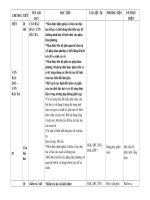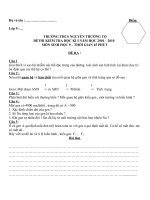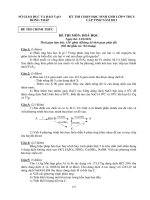Mon 9 oct 11 27
Bạn đang xem bản rút gọn của tài liệu. Xem và tải ngay bản đầy đủ của tài liệu tại đây (151.81 KB, 8 trang )
PART 1
Questions 1-10
Questions 1-7
Complete the notes below.
Write NO MORE THAN THREE WORDS AND/OR A NUMBER for each answer.
TRAVEL AGENCY
Name of tour:
Magic One Day
Departure time:
(1) ............................................ on Saturdays
Return time:
6:00 p.m.
Transportation:
(2) ............................................ or minibus
Group size:
15 – 25 tourists
Cost:
(3) ............................................ per person
Including (4) ………………………………………..
Peak season:
Tourists need to (5) ............................................... 2 days
ahead.
Payment:
(6) ………………………………………..
Reference number of tour:
(7) ………………………………………..
Questions 8-10
Choose THREE letters, A-G.
Which THREE attractions can tourists visit at present in Edinburgh?
A. City Hall
B. Old Castles
C. Zoo
D. Art Studio
E. Royal Palace
F. Seabird Centre
G. Aquarium
1
PART 3
Questions 21-30
Questions 21-25
Choose the correct letter A, B or C.
21 The orientation meeting
23 The number of students in one group is.
A Took place last term
A
2–3
B
Will take place next month
B
3–5
C
Took place last week
C
5–6
22 How many lectures will a student have
in a week?
24 Who will give the group a mark according to its
representative’s presentation?
A One
A Subject advisor
B
Two
B
Tutor
C
Three
C
Dean
25 According to the lecturer, postgraduate course is …
A Relaxed
B
Intensive
C
Interesting
Questions 26-30
Answer the questions below. Write NO MORE THAN THREE WORDS for each answer.
26 What’s the main assessment of course?
(26)
……………………………………
(27)
…………………………………
(28)
…………………………………
27 Who can choose the topic of essay?
28 Where can students find their tutors’ names?
29 What should students use when they borrow
(29)
……………………………………
materials from library?
30 Where can students get the username and
(30)
……………………………………
password?
PART 4
Questions 31-40
Questions 31-32
31 Which of the following animals is the slowest?
A Koala
B
Sloth
C Tortoise
32 What does algae reward sloth?
A Skin
B
Protection
C
Nutrition
2
Questions 33-38
Complete the notes below.
Write NO MORE THAN TWO WORDS AND/OR A NUMBER for each answer.
THE LIVES OF SLOTH
Sloth has a short snout, big round eyes, a (33) ............................... tail, and
small ears. The favorite activity of sloth is to (34) ............................... on the
trees.
Sloth is also classified as (35) ............................... just like horses and
cattle. Average body temperature of sloth is (36) …………………………………
Fahrenheit.
(37) .............................. will affect sloth’s body temperature.
Sloths get everything on tree, even (38) .............................. which comes
from juicy leaves and morning dew.
Questions 39-40
Answer the questions below.
Write NO MORE THAN TWO WORDS AND/OR A NUMBER for each answer.
39 How long does a sloth digest its food?
………………………………………..
40 What substance can help to resolve food in sloth’s stomach?
………………………………………..
READING
Reading passage 1
SLEEPY STUDENTS PERFORM WORSE
A. Staying up an hour or two past bedtime makes it far harder for kids to learn, say scientists who
deprived youngsters of sleep and tested whether their teachers could tell the difference. They could.
If parents want their children to thrive academically, “Getting them to sleep on time is as important
as getting them to school on time," said psychologist Gahan Fallone, who conducted the research
at Brown Medical School.
B. The study, unveiled Thursday at an American Medical Association (AMA) science writers meeting,
was conducted on healthy children who had no evidence of sleep- or learning- related disorders.
Difficulty paying attention was among the problems the sleepy youngsters faced - raising the
question of whether sleep deprivation could prove even worse for people with attention deficit
hyperactivity disorder, or ADHD. Fallone now is studying that question, and suspects that sleep
problems “could hit children with ADHD as a double whammy”.
C. Sleep experts have long warned that Americans of all ages do not get enough shuteye. Sleep is
important for health, bringing a range of benefits that, as Shakespeare put it, “knits up the ravelled
3
sleave of care”. Not getting enough is linked to a host of problems, from car crashes as drivers
doze off to crippled memory and inhibited creativity. Exactly how much sleep correlates with
school performance is hard to prove. So, Brown researchers set out to test whether teachers could
detect problems with attention and learning when children stayed up late - even if the teachers had
no idea how much sleep their students actually got.
D. They recruited seventy-four 6- to 12-year-olds from Rhode Island and southern Massachusetts
for the three-week study. For one week, the youngsters went to bed and woke up at their usual
times. They already were fairly good sleepers, getting nine to 9.5 hours of sleep a night. Another
week, they were assigned to spend no fewer than ten hours in bed a night. The other week, they
were kept up later than usual: First -and second-graders were in bed no more than eight hours and
the older children no more than 6.5 hours. In addition to parents’ reports, the youngsters wore
motion-detecting wrist monitors to ensure compliance.
E. Teachers were not told how much the children slept or which week they stayed up late, but rated
the students on a variety of performance measures each week. The teachers reported significantly
more academic problems during the week of sleep deprivation, the study, which will be published
in the journal Sleep in December, concluded. Students who got eight hours of sleep or less a night
were more forgetful, had the most trouble learning new lessons, and had the most problems paying
attention, reported Fallone, now at the Forest Institute of Professional Psychology.
F. Sleep has long been a concern of educators. Potter-Burns Elementary School sends notes to
parents reminding them to make sure students get enough sleep prior to the school’s yearly
achievement testing. Another school considers it important enough to include in the school’s
monthly newsletters. Definitely, there is an impact on students’ performance if they come to
school tired. However, the findings may change physician practice, said Dr. Regina Benjamin, a
family physician in Bayou La Batre, who reviewed the data at the Thursday’s AMA meeting. “I
don't ask about sleep” when evaluating academically struggling students, she noted. “I’m going
to start.”
G. So how much sleep do kids need? Recommended amounts range from about ten to eleven hours a
night for young elementary students to 8.5 hours for teens. Fallone insists that his own secondgrader get ten hours a night, even when it meant dropping soccer - season that practice did not start
until 7:30 — too late for her to fit in dinner and time to wind down before she needed to be snoozing.
“It’s tough,” he acknowledged, but “parents must believe in the importance of sleep."
Questions 1-4
The text has 7 paragraphs (A - G).
Which paragraph contains each of the following pieces of information?
1
Traffic accidents are sometimes caused by lack of sleep.
……………………
2
The number of children included in the study.
……………………
3
How two schools are trying to deal with the problem.
……………………
4
How the effect of having less sleep was measured.
……………………
Questions 5-8
4
Complete the following sentences using NO MORE THAN TWO WORDS from the text for each
gap.
Fallone is now studying the sleep patterns of children with (5) …………………………………
The researchers used (6) ................................ that show movement to check that children
went to bed at the right time.
Students with less sleep had problems with memory, remembering new material, and (7)
…………………………………
Fallone admitted that it was (8) ................................. for children to get enough sleep.
Questions 9-13
Do the following statements agree with the information given in Reading Passage 1? In
boxes 9-13 on your answer sheet, write
TRUE
if the statement agrees with the information
FALSE
if the statement contradicts the information
NOT GIVEN
If there is no information on this
9
The results of the study were first distributed to principals of American schools.
10 Some of the children in the study had previously shown signs of sleeping problems.
11 The study could influence how doctors deal with children’s health problems.
12 Fallone does not let his daughter play soccer.
13 Staying up later is acceptable if the child is doing homework.
5
Reading passage 2
THE BRAINS BUSINESS
A. For those of a certain age and educational background, it is hard to think of higher education without
thinking of ancient institutions. Some universities are of a venerable age - the University of Bologna
was founded in 1088, the University of Oxford in 1096 - and many of them have a strong sense of
tradition. The truly old ones make the most of their pedigrees, and those of a more recent vintage
work hard to create an aura of antiquity. Yet these tradition-loving (or -creating) institutions are
currently enduring a thunderstorm of changes so fundamental that some say the very idea of the
university is being challenged. Universities are experimenting with new ways of funding (most
notably through student fees), forging partnerships with private companies and engaging in mergers
and acquisitions. Such changes ate tugging at the ivy's toots.
B. This is happening for four reasons. The first is the democratization of higher education “massification". in the language of the educational profession. In the rich world, massification has
been going on for some time. The proportion of adults with higher educational qualifications in
developed countries almost doubled between l975 and 2000. From 22% to 41%. Most of the rich
countries are still struggling to digest this huge growth in numbers. Now massification is spreading
to the developing world. China doubled its student population in the late 1990s, and India is trying
to follow suit.
C. The second reason is the rise of the knowledge economy. The world is in the grips of a “soft
revolution” in which knowledge is replacing physical resources as the main driver of economic
growth. Between 1985 and 1997, the contribution of knowledge-based industries to total value
added increased from 51% to 59% in Germany and from 45% to 51% in Britain. The best companies
are now devoting at least a third of their investment to knowledge-intensive intangibles such as
R&D, licensing, and marketing. Universities are among the most important engines of the
knowledge economy. Not only do they produce the brain workers who man it, they also provide
much of its backbone, from laboratories to libraries to computer networks.
D. The third factor is globalization. The death of distance is transforming academia just as radically
as it is transforming business. The number of people from developed countries studying abroad has
doubled over the past twenty years, to 1.9 million; universities are opening campuses all around
the world; and a growing number of countries are trying to turn higher education into an export
industry. The fourth is competition. Traditional universities are being forced to compete for
students and research grants, and private
9
companies are trying to break into a sector which they regard as “the new health care”. The World
Bank calculates that global spending on higher education amounts to $300 billion a year, or 1 %
of global economic output. There are more than 80 million students worldwide, and 3.5 million
people are employed to teach them or look after them.
E. All this sounds as though a golden age for universities has arrived. However, inside academia,
particularly in Europe, it. does not feel like it. Academics complain and administrators are
locked in bad-tempered exchanges with the politicians who fund them. What has gone wrong?
The biggest problem is the role of the state. If more and more governments are embracing
massification, few of them are willing to draw the appropriate conclusion from their enthusiasm:
that they should either provide the requisite hinds (as the Scandinavian countries do) or allow
universities to charge realistic fees. Many governments have tried to square the circle through
lighter management, but management cannot make up for lack of resources.
F. What, if anything can be done? Techno-utopians believe that higher education is ripe for revolution.
The university, they say, is a hopelessly antiquated institution, wedded in outdated practices such
as tenure and lectures, and incapable of serving a new world of mass audiences and just-in-time
information. “Thirty wars from now the big university campuses will be relics," says Peter Drucker,
a veteran management guru. "I consider the American research university of the past 40 years to be
a failure." Fortunately, in his view, help is on the way in the form of Internet tuition and for-profit
universities. Cultural conservatives, on the other hand, believe that the best way forward is
backward. They think it is foolish to waste higher education on people who would rather study
"Seinfeld" than Socrates, and disingenuous to contuse the pursuit of truth with the pursuit of profit.
Questions 14-17
The text has 7 paragraphs (A - F).
Which paragraph does each of the following headings best fit?
14 Education for the masses.
15 Future possibilities.
16 Globalization and competition.
17 Funding problem.
Questions 18-22
According to the text, FIVE of the following statements are true.
Write the corresponding letters in answer boxes 18 to 22 in any order.
A. Some universities are joining with each other.
B. There are not enough graduates in developed countries.
C. Most companies in developed countries devote a third of their profits to research and
development.
D. The number of people from developed countries studying outside their home countries
has doubled in the last two decades.
E. Scandinavian governments provide enough money for their universities.
F. The largest university in the world is in Turkey.
G. Italian students must have a five – minute interview with a professor before being
accepted into university.
H. Peter Drucker foresees the end of university campuses.
18 …….19 ……20 ……21 ……22 …….
Questions 23-26
Choose the correct letter A, B or C.
23 Universities are responding to changes by
A Constructing new buildings in old styles
so they appear old and traditional
B
Introducing new subjects for study.
C
Charging students higher fees.
24 The knowledge economy is
A On the rise most of all in Germany.
B
Not fully appreciated in Britain.
C
Heavily reliant on universities.
25 Current problems at universities, especially in
Europe, include
A Managers arguing with governments.
B
Problems with management.
C Poor management.
26 Possible solutions put forward by reformists
and conservatives include
A Greater use of technology
B
Employing management gurus to teach
C
Teaching fewer students.
39507









